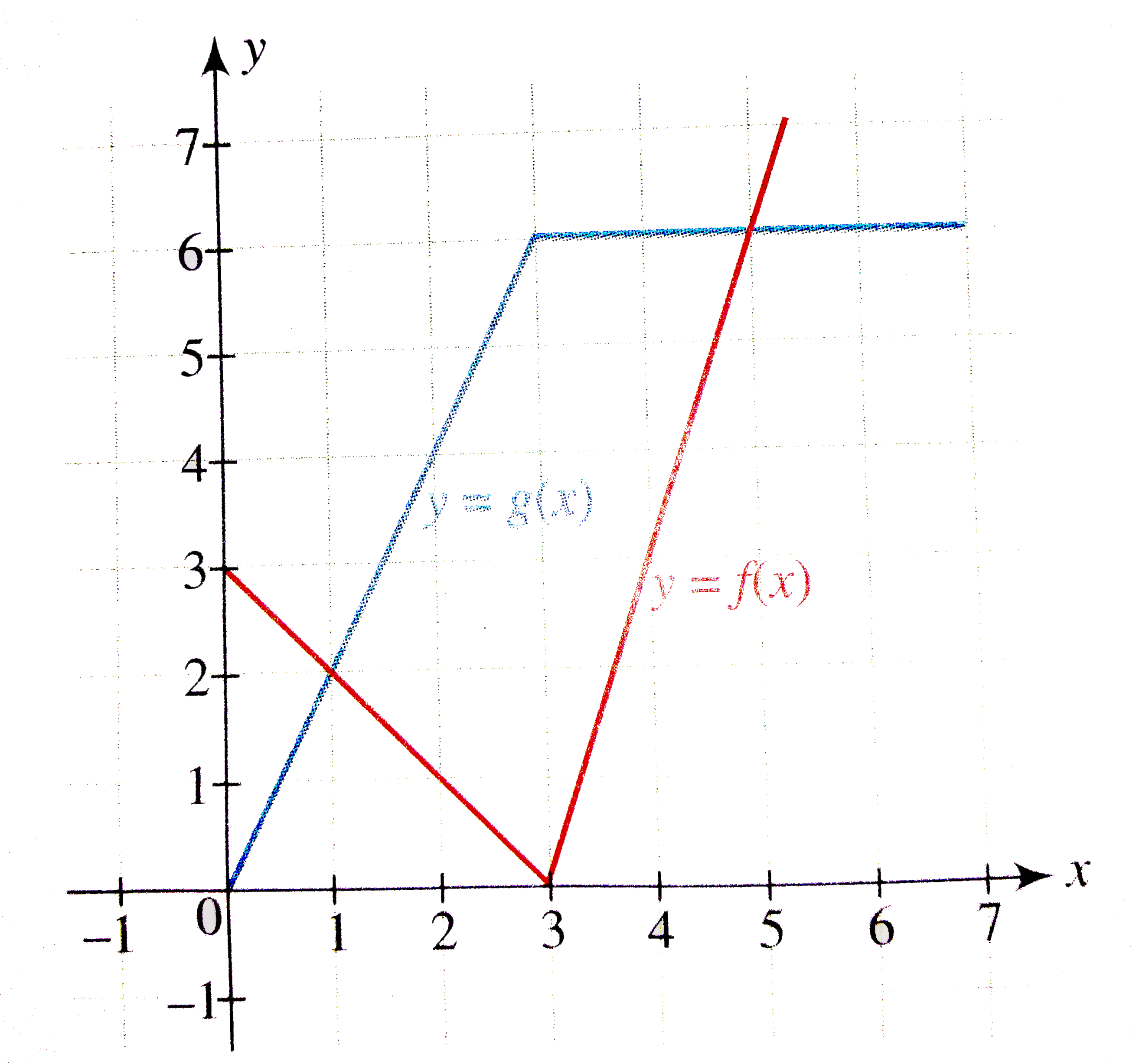We say an equation f(x)=g(x) is consistent, if the curves y=f(x)andy=g(x) touch or intersect at atleast one point. If the curves y=f(x)andy=g(x) do not intersect or touch, then the equation f(x)=g(x) is said to be inconsistent i.e. has no solution.
The equation sinx=x2+x+1 is
consistent and has infinite number of solutions
consistent and has finite number of solutions
inconsistent
None of the above
The correct Answer is:C
To determine whether the equation sinx=x2+x+1 is consistent or inconsistent, we will analyze the functions f(x)=sinx and g(x)=x2+x+1.
Step 1: Analyze the function g(x)=x2+x+1
1. Identify the nature of the quadratic function:
- The quadratic function g(x)=x2+x+1 is a parabola that opens upwards (since the coefficient of x2 is positive).
- To find the vertex of the parabola, we can use the vertex formula x=−b2a, where a=1 and b=1:
x=−12⋅1=−12
- Now, substituting x=−12 into g(x) to find the minimum value:
g(−12)=(−12)2+(−12)+1=14−12+1=34
- Thus, the minimum value of g(x) is 34, which occurs at x=−12.
Step 2: Analyze the function f(x)=sinx
2. Identify the range of the sine function:
- The function f(x)=sinx oscillates between -1 and 1 for all x.
- Therefore, the maximum value of sinx is 1 and the minimum value is -1.
Step 3: Compare the two functions
3. Determine if the two functions can intersect:
- Since the minimum value of g(x) is 34 and the maximum value of f(x) is 1, we need to check if g(x) can equal f(x).
- The function g(x) is always greater than or equal to 34 for all x.
- The function f(x) can take values from -1 to 1, but it can never reach 34 or exceed it.
Step 4: Conclusion
4. Final determination:
- Since g(x) is always greater than or equal to 34 and f(x) can take values only up to 1, there are no points where sinx can equal x2+x+1.
- Therefore, the equation sinx=x2+x+1 is inconsistent, meaning it has no solution.
Final Answer:
The equation sinx=x2+x+1 is inconsistent.
---
- The quadratic function g(x)=x2+x+1 is a parabola that opens upwards (since the coefficient of x2 is positive).
- To find the vertex of the parabola, we can use the vertex formula x=−b2a, where a=1 and b=1:
x=−12⋅1=−12
- Now, substituting x=−12 into g(x) to find the minimum value:
g(−12)=(−12)2+(−12)+1=14−12+1=34
- Thus, the minimum value of g(x) is 34, which occurs at x=−12.
- The function f(x)=sinx oscillates between -1 and 1 for all x.
- Therefore, the maximum value of sinx is 1 and the minimum value is -1.
- Since the minimum value of g(x) is 34 and the maximum value of f(x) is 1, we need to check if g(x) can equal f(x).
- The function g(x) is always greater than or equal to 34 for all x.
- The function f(x) can take values from -1 to 1, but it can never reach 34 or exceed it.
- Since g(x) is always greater than or equal to 34 and f(x) can take values only up to 1, there are no points where sinx can equal x2+x+1.
- Therefore, the equation sinx=x2+x+1 is inconsistent, meaning it has no solution.
The equation sinx=x2+x+1 is inconsistent.
Topper's Solved these Questions
- DY / DX AS A RATE MEASURER AND TANGENTS, NORMALS BOOK - ARIHANT MATHS ENGLISHCHAPTER - DY / DX AS A RATE MEASURER AND TANGENTS, NORMALS EXERCISE - EXERCISE : 5
1 Videos
- DY / DX AS A RATE MEASURER AND TANGENTS, NORMALS BOOK - ARIHANT MATHS ENGLISHCHAPTER - DY / DX AS A RATE MEASURER AND TANGENTS, NORMALS EXERCISE - Exercise (Matching Type Questions)
1 Videos
- DY / DX AS A RATE MEASURER AND TANGENTS, NORMALS BOOK - ARIHANT MATHS ENGLISHCHAPTER - DY / DX AS A RATE MEASURER AND TANGENTS, NORMALS EXERCISE - Exercise (Statement I And Ii Type Questions)
7 Videos
- DIFFERENTIATION BOOK - ARIHANT MATHS ENGLISHCHAPTER - DIFFERENTIATION EXERCISE - Exercise For Session 10
4 Videos
- ELLIPSEBOOK - ARIHANT MATHS ENGLISHCHAPTER - ELLIPSEEXERCISE - Exercise (Questions Asked In Previous 13 Years Exam)
27 Videos
Similar Questions
We say an equation f(x)=g(x) is consistent, if the curves y=f(x)andy=g(x) touch or intersect at atleast one point. If the curves y=f(x)andy=g(x) do not intersect or touch, then the equation f(x)=g(x) is said to be inconsistent i.e. has no solution.
Among the following equations, which is consistent in (0,π/2)?
View SolutionLet us define the function f(x)=x2+x+1
Statement I The equation sinx=f(x) has no solution.
Statement II The curve y=sinx and y=f(x) do not intersect each other when graph is oberved.
View SolutionIf A and B are the points of intersection of y=f(x) and y=f−1(x), then
View SolutionLet f(x)=x3+x+1 and let g(x) be its inverse function then equation of the tangent to y=g(x) at x = 3 is
View SolutionA curve y=f(x) is passing through (0,0). If slope of the curve at any point (x,y) is equal to (x+xy), then the number of solution of the equation f(x)=1, is :
View SolutionIf (-1,2) and and (2,4) are two points on the curve y=f(x) and if g(x) is the gradient of the curve at point (x,y) then the value of the integral ∫2−1g(x)dx is
View SolutionLet f(x)=exsinx , slope of the curve y=f(x) is maximum at x=a if 'a' equals
View SolutionIf f(x) and g(x) are two real functions such that f(x)+g(x)=exandf(x)−g(x)=e−x , then
View SolutionGraph of y=f(x)andy=g(x) is given in the following figure. If h(x)=f(g(x)), then find the value of h'(2).

View SolutionLet f(x)=x2−5x+6,g(x)=f(|x|),h(x)=|g(x)|
The set of values of x such that equation g(x)+|g(x)|=0 is satisfied contains
View Solution
